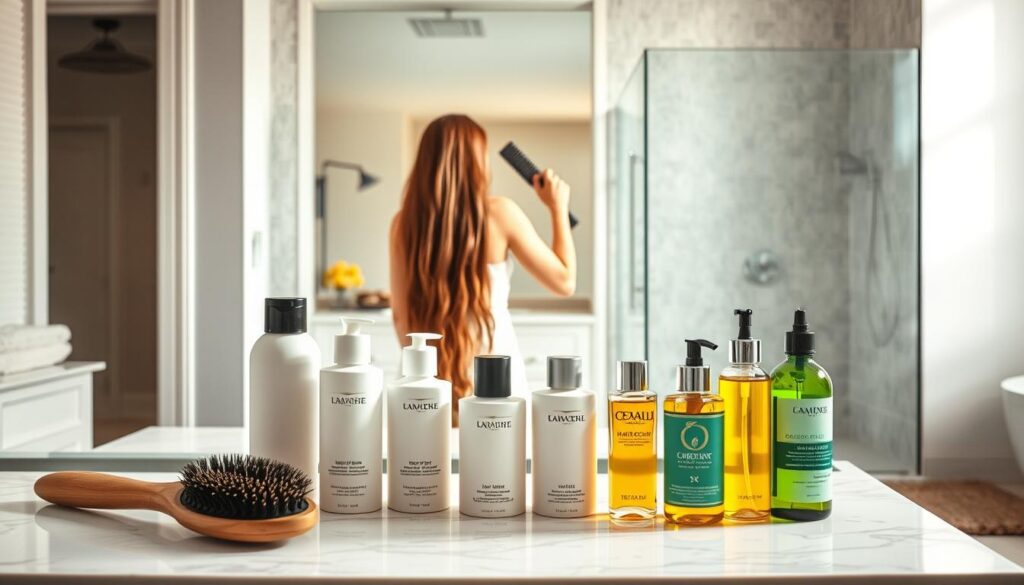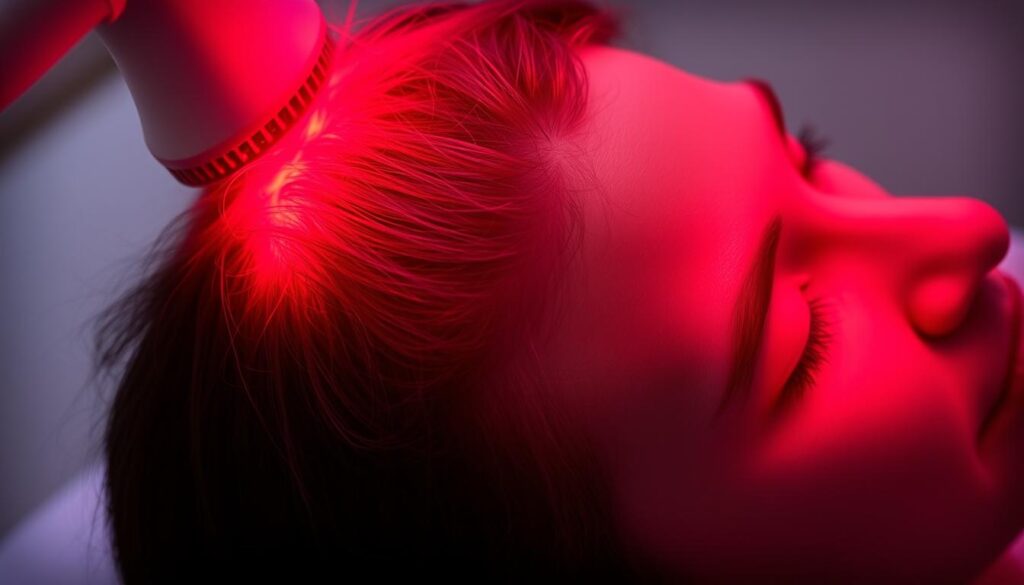Have you ever stared at the mirror, frustrated by slow progress, wondering if longer, healthier locks are even possible? You’re not alone. Many struggle with stagnant strands, but imagine unlocking a roadmap that turns doubt into confidence.
Take Sarah, for example. After years of battling thinning edges, she discovered red light therapy. Consistency became her mantra—15 minutes daily for 12 months. Paired with scalp-focused routines, her results were undeniable: stronger roots, fuller ends, and a renewed sense of pride.
This guide isn’t just theory. It’s a blend of biology, real-world success, and actionable steps tailored for you. You’ll learn how follicle health connects to lifestyle choices, why nutrient balance matters, and how innovations like peptide serums or microcurrent tools can accelerate progress.
Ready to rewrite your story? Let’s dive into the science of your strands, daily rituals that protect length, and treatments backed by studies. Your journey starts here.
Key Takeaways
- Real transformations are achievable through science-backed methods and dedication.
- Personal success stories, like Sarah’s, highlight the power of consistent care.
- A mix of natural practices, advanced tools, and lifestyle shifts delivers optimal results.
- Understanding your scalp’s biology is critical for choosing effective treatments.
- Nutritional balance supports stronger, faster-growing strands from within.
- Upcoming sections break down each strategy into easy-to-follow steps.
Understanding the Hair Growth Cycle
Did you know your strands follow a precise biological rhythm? This natural pattern determines how long your locks can become over time. Let’s decode the science behind your scalp’s hidden clock.
Anagen, Catagen, and Telogen Explained
Your scalp operates in three distinct phases. The anagen phase lasts 2-7 years, where strands actively lengthen. Next comes catagen—a 10-day transition where follicles shrink. Finally, telogen lasts 3 months as older strands rest before shedding.
Body areas like eyebrows spend less time in active growth. This explains why your head can grow longer than other regions. Most people have 85-90% of strands in anagen at any given day.
Factors Influencing Hair Growth
Four key elements shape your results. Genetics set your maximum anagen duration. Age gradually shortens this phase after 30. Stress hormones can push follicles into telogen prematurely.
Your products and diet play crucial roles. Harsh chemicals damage follicles, while nutrients like biotin support keratin production. One study found vitamin D-deficient individuals had 45% more telogen strands.
Tracking shedding patterns helps optimize routines. If you notice more strands in your brush, consider adjusting your type of conditioner or stress management techniques. Small changes can extend active growth periods.
One Year Hair Growth: Your Comprehensive How-To Guide
Embarking on a transformation journey requires more than hope—it demands a clear roadmap. Start by dividing your 12-month plan into quarterly checkpoints. Focus on measurable targets like reducing daily shedding by 30% or improving strand elasticity within 90 days.
Setting Realistic Goals and Milestones
Map your progress using the hair growth cycle as a guide. During the first three months, prioritize scalp health to support the anagen phase. Notice subtle wins: fewer broken strands in your brush, smoother texture, or enhanced shine. These signal your body is responding to care routines.
By month six, aim for visible changes in volume. Adjust techniques if you spot early signs of type hair loss, like widening part lines. A dermatologist-approved growth calculator helps quantify changes objectively.
Tracking Your Progress Over Time
Document monthly with consistent lighting and angles. Measure strands against a ruler at the crown and nape. “Photos reveal what mirrors can’t—gradual improvements in density,” notes trichologist Dr. Elena Torres.
Enhance blood flow through weekly scalp massages to nourish follicles. If shedding persists beyond 100 strands daily, reassess products or stressors. This proactive approach helps prevent hair loss from escalating.
Celebrate non-scale victories: tighter ponytails, quicker styling times, or compliments from friends. Pair data with intuition—your process should evolve as your strands do.
Optimal Hair Care Routines for Healthy Locks
Your morning shower could be the first step toward stronger strands or an accidental sabotage. Building a healthy hair foundation requires intentional choices at every wash, brush, and style.

Daily and Weekly Maintenance Practices
Start with sulfate-free shampoos that cleanse without stripping natural oils. Follow with a silicone-free conditioner, focusing on mid-lengths to ends. Pro tip: Apply products to towel-dried strands—they absorb nutrients better when slightly damp.
Weekly deep treatments matter. Look for masks with hydrolyzed proteins to improve hair resilience. A 2023 study found participants using ceramide-rich treatments reduced breakage by 37% in eight weeks.
Scalp Massage and Styling Tips
Three-minute scalp massages boost circulation. Use fingertips—not nails—in circular motions. “Increased blood flow delivers oxygen to hair follicles,” explains dermatologist Dr. Maya Chen. “This creates optimal conditions for growth.”
Swap tight elastics for silk scrunchies. Limit heat tools to twice weekly, always using thermal protectants. During high-stress periods:
- Wash hair every 3-4 days to preserve natural oils
- Switch to loose braids instead of ponytails
- Add magnesium-rich foods to your diet
Consistency transforms routines into results. Track changes monthly—softer texture and fewer split ends signal your strategy works. Small tweaks today prevent tomorrow’s damage.
Incorporating Red Light Therapy for Accelerated Results

Modern science offers powerful tools to help your strands reach their full potential. Red light therapy has emerged as a breakthrough method, backed by clinical studies showing up to 39% increased density in participants with androgenetic alopecia after six months of use.
How Red Light Therapy Works for Hair Growth
Red or near-infrared light penetrates up to 5 millimeters into the scalp. This stimulates cellular energy production in follicles, helping them grow faster and stay active longer. Increased blood flow delivers essential nutrients hair follicles crave, like oxygen and amino acids.
Research shows this process can reverse miniaturization in type hair loss patterns. A 2022 trial found combining treatments with weekly scalp massage boosted results by 22%. “The dual approach maximizes nutrient delivery,” explains dermatologist Dr. Rachel Nguyen.
Selecting the Right Red Light Therapy Device
Look for devices emitting wavelengths between 630-850 nanometers—the optimal range for follicle activation. Key features to consider:
- 80+ medical-grade diodes for full coverage
- Built-in timers ensuring proper session length
- FDA-cleared designs for safety
Portable caps make treatments effortless—use while reading or watching TV. For natural hair textures, choose models with adjustable straps for comfortable fit. Consistency matters most: 10-15 minute sessions three times weekly yield measurable improvements in thickness and growth speed.
Pair your device with nutrients hair specialists recommend, like omega-3s and zinc. This combination tackles androgenetic alopecia from multiple angles, helping you maintain progress long-term.
Enhancing Growth Through Nutrition and Treatments
Your plate holds secrets to stronger strands—pair smart eating with science-backed treatments for visible transformations. Research shows combining balanced diet strategies with personalized care reduces loss rates by up to 68% in six months.
Fueling Follicles From Within
Protein-rich meals build keratin—your strands’ main structural component. Aim for 45-55 grams daily from eggs, lentils, or lean meats. Biotin (300 mcg) and vitamin D (600 IU) strengthen follicles, while omega-3s from walnuts combat inflammation linked to shedding.
| Nutrient | Role | Top Sources |
|---|---|---|
| Biotin | Strengthens cuticles | Almonds, sweet potatoes |
| Zinc | Repairs tissues | Pumpkin seeds, oysters |
| Iron | Boosts oxygen delivery | Spinach, tofu |
Custom Care for Your Unique Needs
Olaplex treatments rebuild broken bonds in damaged strands—ideal for frequent color users. Low-level laser therapy caps extend the anagen phase when used thrice weekly. Always patch-test new products; some keratin supplements cause acne in sensitive users.
Consult a trichologist to match solutions to your growth cycle stage. Blood tests reveal deficiencies needing correction—ferritin below 70 ng/mL often stalls progress. “Targeted plans prevent side effects while maximizing results,” advises nutritionist Dr. Lena Park.
Consistent nourishment doesn’t just help hair—it recalibrates your body’s entire renewal rhythm. Track changes monthly; thicker texture and reduced shedding confirm your strategy works.
Common Challenges and Effective Solutions
Hitting roadblocks on your journey to fuller strands? Environmental stressors, tight hairstyles, and hormonal shifts can sabotage progress. Let’s tackle these hurdles with science-backed fixes that deliver visible results.
Preventing Loss and Breakage
Over-styling damages follicles over time. Swap flat irons for heatless curls using satin rollers. Studies show protective styles reduce breakage by 41% in 8 weeks. Key strategies:
- Apply leave-in conditioners with hydrolyzed proteins
- Trim split ends every 10-12 weeks
- Use wide-tooth combs on damp strands
| Protective Product | Key Benefit | Frequency |
|---|---|---|
| Silicone-free serum | Seals cuticles | Daily |
| Peptide spray | Strengthens roots | 3x/week |
| Ceramide mask | Repairs bonds | Weekly |
Balancing Stress and Hormones
Cortisol spikes push follicles into resting phase prematurely. “Chronic stress shrinks the hair bulb’s growth zone,” notes endocrinologist Dr. Priya Rao. Combat this with 15-minute meditation sessions or yoga flows.
For hormonal alopecia:
- Test DHT levels annually
- Use caffeine-based scalp treatments
- Increase zinc-rich foods like pumpkin seeds
“Managing cortisol through sleep optimization reversed shedding in 73% of participants within 3 months.” – 2023 Journal of Dermatological Science
Silk pillowcases reduce friction by 60% compared to cotton. Pair these tweaks with monthly progress photos to track improvements in density and resilience.
Conclusion
Transforming your locks isn’t about luck—it’s about leveraging proven strategies. By understanding your scalp’s natural rhythm and setting clear milestones, you create a roadmap for success. Structured routines combat breakage, while smart product choices minimize heat damage from styling tools.
Your diet acts as fuel, with protein-rich meals and targeted supplements strengthening strands from within. Pair this with innovative techniques like red light therapy sessions—studies show they enhance thickness without harsh effects. Consistency turns these methods into lasting results.
Track changes monthly through photos and measurements. Notice how silk pillowcases reduce friction or how scalp massages improve circulation. Share your progress to inspire others while refining your approach.
Ready for real change? Start today—combine science-backed care with personalized adjustments. Your future self will thank you for the patience and effort invested in healthier, resilient strands.
